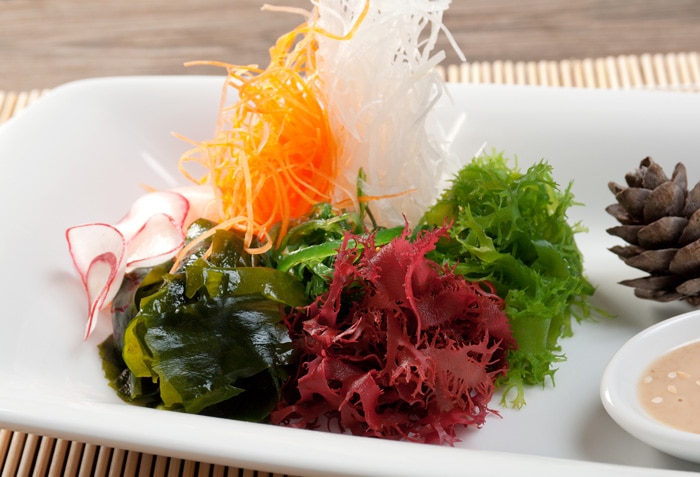
Written By: Sofia Layarda, MPH
Title: Master of Public Health
Alumni: University of California, Berkeley
Last Updated on:

We know that the ocean provides a lot of amazing nutrition. One ocean item gaining popularity in North America is sea vegetables, or seaweed. In some countries, such as Japan, seaweed forms an integral part of the cuisine, so many types of sea vegetables are identified by their Japanese names.

Table of Contents
Collectively, sea vegetables are very low in calories, fat free, high in fiber, and an excellent source of the mineral iodine. They are also a good source of the minerals magnesium (important in blood pressure regulation, cardiovascular health, and diabetes prevention), calcium (bone and dental health), and iron. Seaweed also contains some Vitamin C, which may improve the bioavailability of the iron.
Sea vegetables are also high in substances called sulfated polysaccharides, which have been shown to exhibit anticoagulant, antimicrobial, antioxidant, and anticancer activities. These polysaccharides include fucoidans in brown algae, carrageenans in red algae, and ulvans in green algae. Sea vegetables are also high in unsaturated fatty acids, including omega-3 fatty acids. For example, dulse contains high levels of the “fish fatty acid,” omega-3 eicosapentaenoic acid (EPA), according to a Dutch study published June 2011 in the Lipids in Health and Disease journal.
There is some concern about heavy metal contamination of seaweed, since sea vegetables are particularly effective at taking up minerals from seawater. Because harvesting or cultivation practices vary depending on the source, the safest bet is to find certified organic products that fully disclose the results of lab testing for heavy metals on the package.
This type of seaweed is well known to sushi lovers as the wrap for sushi rolls. It ranges in color from deep green to almost black and comes in different grades. The nori sheets used for sushi are actually pre-toasted and called sushi nori. You can also buy individually wrapped toasted, seasoned nori strips, but remember to read the label, as some brands are very high in added salt or seasonings such as MSG.
Both hijiki and arame are species of brown algae with very fine, thin fronds. Whole hijiki resembles a bundle of lustrous black hair. Arame has the smallest strands and the most delicate flavor of all the sea vegetables. Because these sea vegetables are so delicate, they can easily be sprinkled on soups, salads, or stir-fries after a brief soaking.
Kombu is sometimes called kelp, and is a brown algae with tall fronds that grows in thick underwater “forests.” Dried kombu is usually found as wide, flat blades or sheets with a whitish coating on the surface. The whitish coating is actually naturally occurring glutamic salts that have dried on the kombu’s surface as the harvested kelp is dried in the sun. These salts have strong umami flavor and make kombu a popular flavoring agent in soups. Kombu is an integral component of Japanese dashi (broth), and is frequently added to bean stews because it helps cut cooking time and makes the beans easier to digest. To use kombu, gently wipe with a damp cloth to preserve the glutamic salts – don’t rinse them off. Kombu can also be dry-toasted in a pan (without oil) over medium heat until crispy, then pounded into a powder that can be added to salads, rice, or soups. If you can find dried kombu in big sheets, they can be wrapped around fish filets or other seafood to infuse extra flavor while cooking.
Wakame is another species of brown algae, but with long, delicate leaves. It is most familiar to us as the bright green seaweed found in miso soup. To reconstitute dried wakame, simply soak in water for 10 to 15 minutes. Dried wakame doubles in size once soaked. Once reconstituted, wakame makes an easy addition to salads, stir-fries, or soups (remove any tough ribs before adding). Like kombu, wakame contains glutamic salts that contribute umami, or flavor, and can be found sold as flakes that can be used as a topping on rice. The flakes work great on omelets or as popcorn topping, too!
Dulse, a red sea vegetable, grows along the northern coasts of both the Atlantic and Pacific oceans. Dulse can be found in the cuisines of coastal North America and northern Europe. It has a tangy flavor that makes it an easy addition to soups, salads, porridge, or baked goods.
Just like anything new that you wish to add to your current diet, start small and add more gradually. Seaweed can be expensive (particularly the higher-grade, organic varieties) but you do not need to add much daily in order to enjoy its flavor and benefits. Add chopped seaweed to salads and soups or use to top omelets or pizza. Sea vegetables can also complement noodle dishes and vegetable stir-fries.
Alumni: University of California, Berkeley – Sofia believes in bringing back fun and pleasure into everyday eating. She loves cooking, and is constantly experimenting with ingredients, creating recipes and trying them out on family and friends. Her latest interest lies in finding realistic and practical ways of environmentally-friendly food/eating habits.
calcium, diabetes diet, epa, grocery aisle, magnesium, omega-3, sea vegetables, seaweed, vegetables, vegetarian